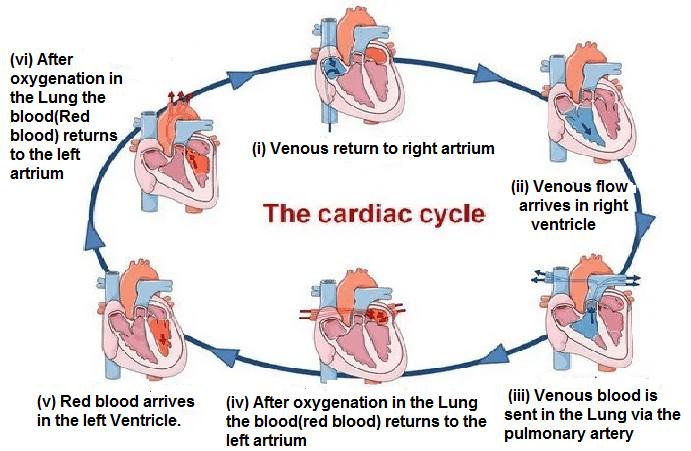Cardiac Cycle










Cardiac Cycle
Human Heart
Structure of Human Heart :-
The heart is a muscular, conical and dark red coloured organ that act as a pump of the blood circulatory system in our body.In man, the heart weighs about 0.43 % of the body.The heart is made up of special type of muscles known as cardiac muscles. These muscles contract with considerable force, squeezing the blood out into the arteries which carries it to the different body parts. A single cycle of circulation of blood into the heart is known as cardiac cycle.
Mechanism of Cardiac Cycle :-

The heartbeat of normal adult human being is ________________________ . | |||
| Right Option : B | |||
| View Explanation | |||
Which of the following are correct ? (a) Cardiac cycles is the sequence of alternating contraction and relaxation of the atria and ventricles of the heart to pump blood through out the body. It lasts approximately 0.8 seconds. (b) The heart beats non stop throughout one’s life. | |||
| Right Option : C | |||
| View Explanation | |||
In the cardiac cycle both atria and ventricle relaxes for a short period. This is known as _____________________ . | |||
| Right Option : C | |||
| View Explanation | |||
Students / Parents Reviews [10]
It was a good experience with Abhyas Academy. I even faced problems in starting but slowly and steadily overcomed. Especially reasoning classes helped me a lot.

Cheshta
10thMy experience was very good with Abhyas academy. I am studying here from 6th class and I am satisfied by its results in my life. I improved a lot here ahead of school syllabus.

Ayan Ghosh
8thMy experience with Abhyas is very good. I have learnt many things here like vedic maths and reasoning also. Teachers here first take our doubts and then there are assignments to verify our weak points.

Shivam Rana
7thOne of the best institutes to develope a child interest in studies.Provides SST and English knowledge also unlike other institutes. Teachers are co operative and friendly online tests andPPT develope practical knowledge also.

Aman Kumar Shrivastava
10thIt has a great methodology. Students here can get analysis to their test quickly.We can learn easily through PPTs and the testing methods are good. We know that where we have to practice

Barkha Arora
10thMy experience with Abhyas academy is very good. I did not think that my every subject coming here will be so strong. The main thing is that the online tests had made me learn here more things.

Hiya Gupta
8thA marvelous experience with Abhyas. I am glad to share that my ward has achieved more than enough at the Ambala ABHYAS centre. Years have passed on and more and more he has gained. May the centre flourish and develop day by day by the grace of God.

Archit Segal
7thI have spent a wonderful time in Abhyas academy. It has made my reasoning more apt, English more stronger and Maths an interesting subject for me. It has given me a habbit of self studying

Yatharthi Sharma
10thAbhyas is a complete education Institute. Here extreme care is taken by teacher with the help of regular exam. Extra classes also conducted by the institute, if the student is weak.

Om Umang
10thAbout Abhyas metholodology the teachers are very nice and hardworking toward students.The Centre Head Mrs Anu Sethi is also a brilliant teacher.Abhyas has taught me how to overcome problems and has always taken my doubts and suppoeted me.
